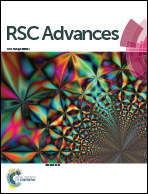Catalyst-free reductive cyclization of bis(2-aminophenyl) disulfide with CO2 in the presence of BH3NH3 to synthesize 2-unsubstituted benzothiazole derivatives†
Abstract
An efficient and catalyst-free methodology for the reductive cyclization of various disulfides using BH3NH3 as a reductant and CO2 as a C1 resource was developed. The desired 2-unsubstituted benzothiazole derivatives were obtained in good to excellent yields. Moreover, mechanism investigation demonstrated that BH3NH3 played an important role in the formation of benzothiazole. As a reducing agent, BH3NH3 reduced CO2 and cleaved the S–S bond of the disulfide efficiently. In addition, the N–H bond of the amino group was also activated by BH3NH3. To the best of our knowledge, this is an unprecedented catalyst-free protocol for the synthesis of 2-unsubstituted benzothiazole from bis(2-aminophenyl) disulfide and CO2.



 Please wait while we load your content...
Please wait while we load your content...